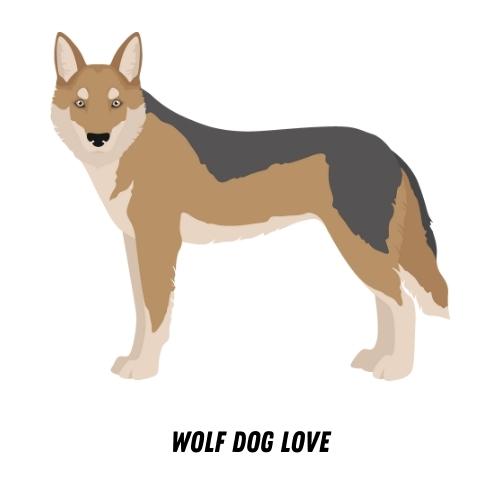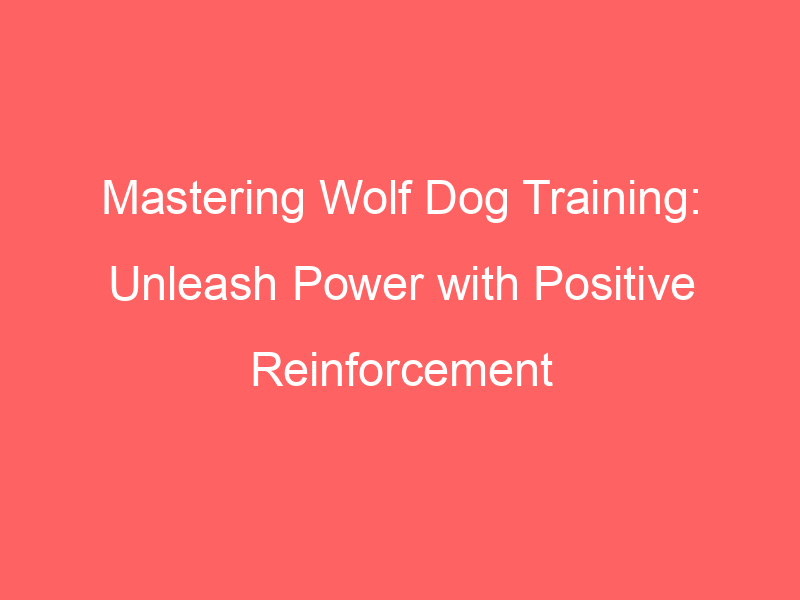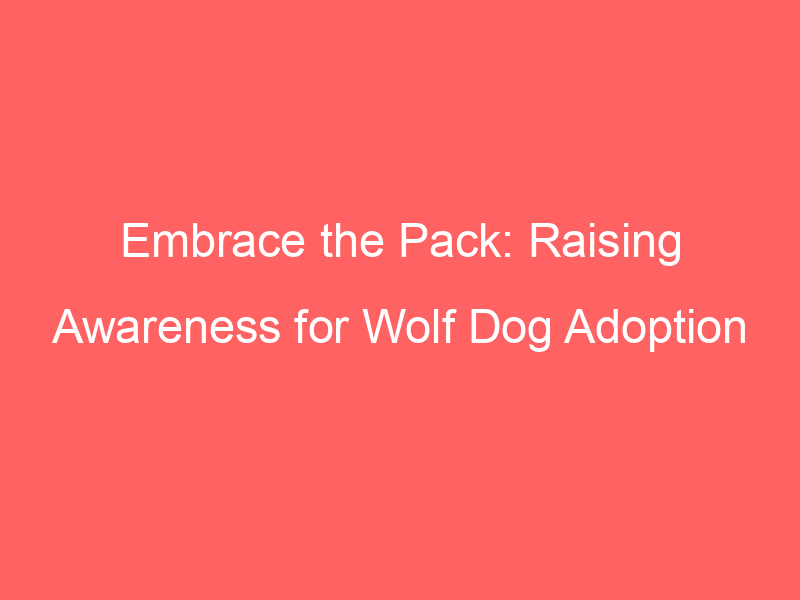Introduction to Wolf Dog Training
Wolf dogs are unique creatures, a fascinating blend of domestic dog and wild wolf. Training these special animals requires a deep understanding of their distinct behaviors and needs. In this article, we’ll explore the unique challenges of wolf dog training and the importance of using positive reinforcement techniques.
-
Understanding the Unique Challenges of Wolf Dog Training
Wolf dogs are not your typical pets. They possess the instincts of a wild animal, combined with the traits of a domestic dog. This mix can lead to certain challenges when it comes to training. Wolf dogs are highly intelligent and independent, which can make them more difficult to train than other breeds.
They are also known for their strong prey drive and territorial behavior, which can pose additional challenges. However, with patience, consistency, and the right approach, it is possible to train a wolf dog effectively.
-
Importance of Positive Reinforcement Techniques in Wolf Dog Training
Positive reinforcement is a method of training that rewards good behavior, rather than punishing bad behavior. This approach is particularly effective with wolf dogs, as it builds trust and encourages them to repeat the desired behavior.
For example, if your wolf dog sits on command, you might reward them with a treat or a favorite toy. This positive reinforcement helps them understand that sitting when asked results in a reward, encouraging them to repeat the behavior in the future.
Remember, wolf dogs are intelligent and sensitive animals. Harsh punishment can damage your relationship with them and make training more difficult. Always use positive reinforcement techniques to encourage good behavior and build a strong, trusting bond with your wolf dog.
Understanding Wolf Dog Behavior
Wolf Dogs are unique creatures, a fascinating blend of domestic dog and wild wolf. Understanding their behavior is crucial to successful training. Let’s delve into the key behavioral traits of Wolf Dogs and how this knowledge can aid in their training.
- Key behavioral traits of Wolf Dogs
Wolf Dogs are known for their intelligence and independence. They are highly curious, always eager to explore their surroundings. Their wolf heritage makes them more alert and aware of their environment than most domestic dogs.
Wolf Dogs are also pack animals. They thrive in a family setting and are extremely loyal. However, their pack mentality means they may try to assert dominance, especially if they do not see a clear leader in their human family.
They are also highly energetic and require plenty of physical and mental stimulation. Without it, they may become bored and potentially destructive. It’s important to provide them with plenty of playtime and mental challenges.
- How understanding Wolf Dog Behavior aids in training
Understanding these key behaviors can greatly aid in training your Wolf Dog. For instance, knowing that they are pack animals can help you establish yourself as the pack leader. This can make training much easier as your Wolf Dog will be more likely to follow your commands.
Similarly, understanding their need for physical and mental stimulation can help you devise effective training methods. Incorporating play and challenges into training sessions can make them more engaging for your Wolf Dog, increasing the likelihood of success.
Lastly, recognizing their intelligence and curiosity can help you keep training sessions interesting. Changing up routines and introducing new commands or tricks can keep your Wolf Dog engaged and eager to learn.
In conclusion, understanding your Wolf Dog’s behavior is not just interesting, it’s essential for effective training. By recognizing and working with their unique traits, you can create a strong bond with your Wolf Dog and help them become a well-behaved, happy member of your family.
Empowering Dog Training: The Positive Approach
Training your dog doesn’t have to be a daunting task. With the right approach, it can be an empowering and rewarding experience for both you and your furry friend. This section will explore the positive approach to dog training, focusing on the methods that encourage good behavior and foster a strong bond between you and your dog.
Positive Dog Training Methods
Positive dog training is a method that focuses on rewarding good behavior rather than punishing bad behavior. This approach is not only more humane but also more effective in teaching your dog what you expect from them. Here are some methods to consider:
- Using rewards for positive behavior
- Ignoring negative behavior
- Consistency in training
When your dog behaves in a way that you want them to, reward them. This can be in the form of treats, praise, or extra playtime. The key is to make sure the reward is immediate, so your dog associates the reward with the behavior.
Instead of punishing your dog for bad behavior, ignore it. Dogs crave attention and by ignoring the behavior, you are showing them that they will not get what they want by behaving badly. Over time, they will learn that good behavior gets them attention and rewards.
Consistency is key in dog training. Make sure to use the same commands and rewards each time. This will help your dog understand what you expect from them and will make the training process smoother.
Remember, patience is crucial when training your dog. It might take some time for your dog to understand and respond to your commands, but with consistency and positivity, you will see progress. The positive approach to dog training is not just about teaching your dog, it’s about building a strong and trusting relationship with them.
Canine Positive Reinforcement: Case Studies
Let’s explore a couple of real-life examples that show the power of positive reinforcement in dog training. These case studies will help you understand how these techniques can transform the behavior of your wolf dog.
-
Case study 1: Successful implementation of Positive Reinforcement Techniques
Meet Max, a 2-year-old German Shepherd who was known for his aggressive behavior. Max’s owner, Lisa, decided to try positive reinforcement techniques to improve his behavior. She started rewarding Max with treats and praises whenever he behaved well. She also ignored him when he showed aggressive behavior.
After a few weeks of consistent training, Lisa noticed a significant change in Max’s behavior. He became less aggressive and more obedient. This case study shows the power of positive reinforcement in dog training. It’s all about rewarding good behavior and ignoring the bad ones.
-
Case study 2: Transformation of a Wolf Dog with Positive Dog Training Methods
Next, let’s look at the story of Luna, a 3-year-old Wolf Dog. Luna was very shy and fearful, which made it difficult for her owner, John, to train her. John decided to use positive dog training methods to help Luna overcome her fears.
John started by rewarding Luna with her favorite treats whenever she showed bravery. He also ignored her when she showed fear. After a few months of consistent training, Luna became more confident and less fearful. This case study shows how positive dog training methods can help transform a fearful dog into a confident one.
In conclusion, positive reinforcement techniques can be very effective in dog training. They can help improve a dog’s behavior and build a strong bond between the dog and its owner. So, if you’re struggling with your wolf dog’s behavior, consider trying these techniques.
Wolf Dog Obedience: Training Tips and Techniques
Training a wolf dog can be a challenging but rewarding experience. With the right techniques, you can establish a strong bond with your pet and ensure their obedience. Here are some empowering training techniques that can help you in this journey.
Empowering Training Techniques
These techniques are designed to help you effectively train your wolf dog while also fostering a positive relationship with them.
-
Establishing Leadership
Wolf dogs are pack animals, and they naturally look for a leader. By establishing yourself as the leader, you can guide their behavior more effectively. This doesn’t mean being harsh or domineering. Instead, it’s about showing confidence, setting boundaries, and being consistent in your interactions.
-
Creating a Structured Environment
Wolf dogs thrive in structured environments. This means having set times for meals, walks, and playtime. A structured environment helps them understand what is expected of them and reduces anxiety and destructive behavior.
-
Regular Exercise and Mental Stimulation
Just like their wolf ancestors, wolf dogs are highly active and intelligent animals. Regular exercise and mental stimulation are crucial for their well-being. This could involve long walks, playtime with toys, and obedience training exercises. Mental stimulation can also come from puzzle toys and learning new commands.
Remember, every wolf dog is unique and may respond differently to various training techniques. It’s important to be patient, consistent, and positive in your approach. With time and effort, you can help your wolf dog become a well-behaved and obedient companion.
Wolf Dog Training Tips
Training a wolf dog requires a unique approach. Here are some essential tips to help you on your journey.
- Tip 1: Patience and Consistency
- Tip 2: Using the Right Rewards
- Tip 3: Understanding and Responding to Body Language
Training a wolf dog is not a one-day affair. It takes time and patience. Consistency is key in this process. Make sure to keep your training sessions regular and consistent. This helps your wolf dog understand what is expected of them and helps them learn faster. For example, if you’re teaching your wolf dog to sit, make sure to practice this command at the same time each day.
Wolf dogs respond well to rewards. However, it’s important to use the right kind of rewards. Wolf dogs are not as food-motivated as other breeds, so treats might not always work. Instead, try using praise, petting, or a favorite toy as a reward. Remember, the goal is to make your wolf dog associate good behavior with positive experiences.
Wolf dogs have a rich body language. Understanding and responding to their body language can greatly enhance your training sessions. For instance, if your wolf dog’s ears are pinned back and their tail is tucked, they might be feeling scared or anxious. In such cases, it’s best to stop the training session and try again later when your wolf dog is more relaxed.
In conclusion, training a wolf dog requires patience, the right rewards, and an understanding of their body language. With these tips in mind, you’re well on your way to having a well-trained wolf dog.
Conclusion: Mastering Wolf Dog Training
As we reach the end of our journey into the world of wolf dog training, it’s important to reflect on what we’ve learned and how we can apply these lessons to our own experiences. Training a wolf dog is not a task to be taken lightly, but with the right knowledge and techniques, it can be a rewarding and fulfilling endeavor.
- Recap of Positive Reinforcement Techniques and Empowering Dog Training
- Key takeaways for successful Wolf Dog Training
- Understanding your wolf dog’s behavior is crucial. This requires observing their actions and reactions in different situations.
- Positive reinforcement is a powerful tool. Reward your wolf dog for good behavior to encourage more of it.
- Building a strong bond with your wolf dog is essential. This relationship is the foundation of successful training.
- Consistency is key. Keep your training sessions regular and consistent to help your wolf dog understand what is expected of them.
Throughout this guide, we’ve emphasized the importance of positive reinforcement in training your wolf dog. This method, which rewards good behavior rather than punishing bad, has been proven to be highly effective in shaping a wolf dog’s behavior. We’ve also discussed empowering dog training, a method that focuses on building a strong, trusting relationship between you and your wolf dog. This approach encourages your dog to make good choices on its own, fostering independence and confidence.
Wolf dog training is a complex process that requires patience, consistency, and understanding. Here are some key takeaways to remember:
In conclusion, mastering wolf dog training is a journey of understanding, patience, and consistency. With the right approach and techniques, you can build a strong, trusting relationship with your wolf dog and help them become a well-behaved and confident member of your family.








